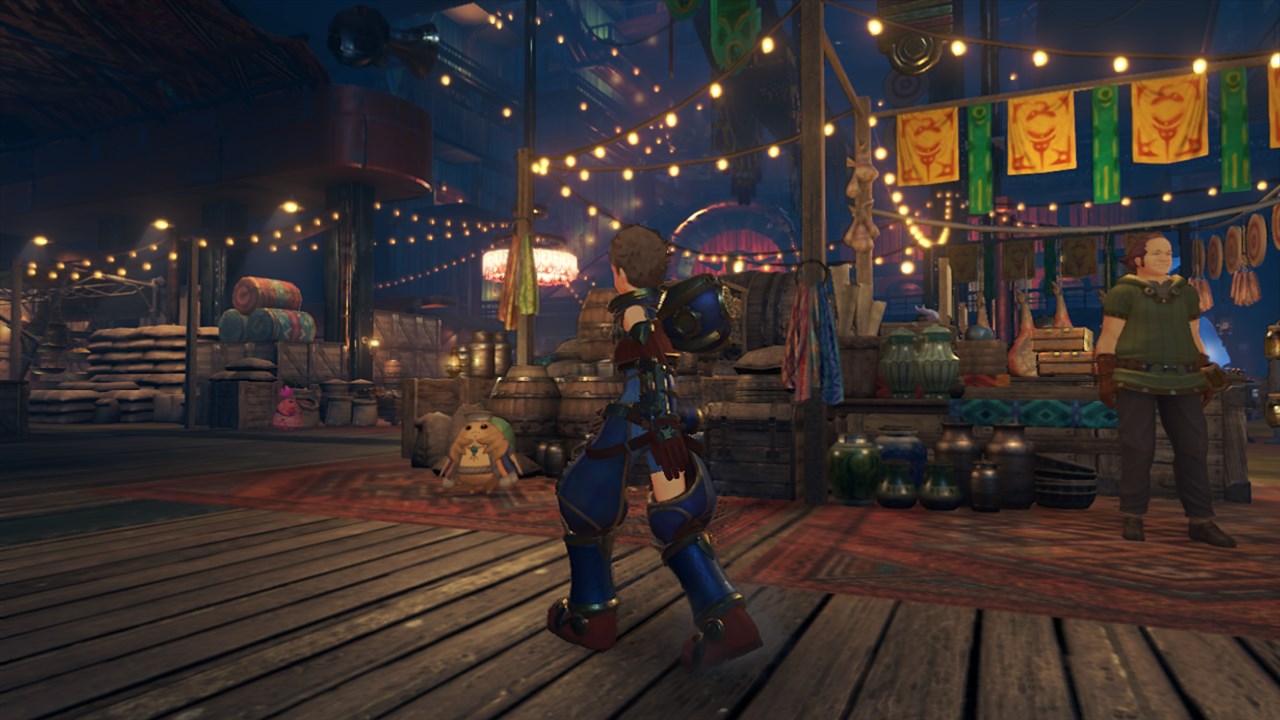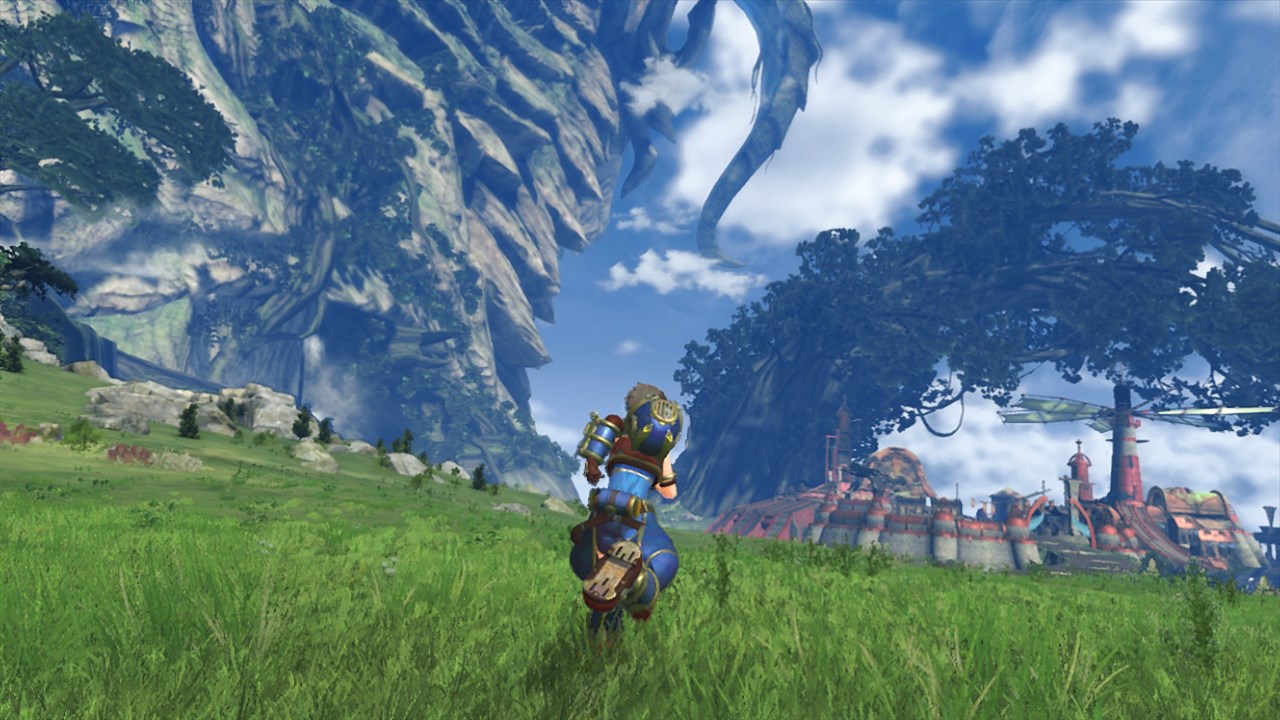
Monolith Soft founder Tetsuya Takahashi is obsessed with insanely grand things. The creator of the acclaimed Xeno series of thoughtful, metaphysics-tinged roleplaying games has an instinctive partiality for Homeric backdrops, Brobdingnagian beings and restive systems of play.
There’s a reason for this, says Takahashi, who spoke with TIME about his studio’s forthcoming Nintendo Switch game Xenoblade Chronicles 2‘s themes and symbols, what it’s like designing for Nintendo’s new console, how Final Fantasy icon (and longtime Square Enix employee) Tetsuya Nomura wound up fashioning a character for the game, and why Takahashi can’t stop creating gargantuan playgrounds.
TIME: I’ve been replaying Xenogears [a 1998 PlayStation game and Takahashi’s first full directorial debut] and noticed that the memory cube icon for saving the game looks a bit like the Monado from Xenoblade Chronicles. It got me wondering if there’s a visual motif you’re carrying through these games.
Tetsuya Takahashi: In Xenoblade Chronicles 2, there are what we call core crystals, the blue crystals you might have seen in the trailer, and these act as the game’s version of the memory cube or Monado. I think you’ll notice that the female character also has a mysterious, interesting-shaped crystal on her chest. As you play the game, you’ll come to understand why it’s shaped that way.

That shape almost looks like a religious cross, and Elysium [the name of a location the protagonists are searching for in the game] signifies something like heaven or paradise. Are you playing at all off Judeo-Christianity?
It’s nothing directly related to or connected to anything biblical or the Bible itself, but I think looking at it conceptually, it’s similar.
When we spoke about your last game, Xenoblade Chronicles X, you told me you’d distanced yourself from philosophical themes in that game’s core story. Where do your interests along those lines lie these days?
In terms of a theme in Xenoblade Chronicles 2, there are all of these Titans, and their lifespan is about to end. The people living on these Titans now have to find a way to continue their lives, because the land they’ve lived on is about to die. So it’s about these people’s quest to find where to live.
Also, there are these lifeforms called Blades. They’re not human, as the title indicates — the “Xeno” part of the title, which means they’re not human. They’re unique lifeforms, and there’s this theme of how humans and Blades can coexist and learn to live with each other, and learn to not only coexist, but protect the world that they live in.

Xenoblade Chronicles 2 seems to have come together must quicker than Xenoblade Chronicles X. What’s it like working with the Switch compared to the Wii U?
The ease or speed of developing Xenoblade Chronicles 2 stems a lot from our having already created this architecture with Xenoblade Chronicles X. The game portion of Xenoblade Chronicles 2 is kind of overlaid on top of that fundamental architecture. I think that made the biggest contribution to why development went so fast. And in terms of Switch versus Wii U, another point is that we’ve only had to deal with one screen, so that also has made development a little bit easier.
And so to add to that, both at Nintendo and at Monolith, we wanted to have a major large-scale roleplaying game early in the Switch’s lifecycle. We thought about how we might accomplish that, and we wanted to do the same thing with the Wii U. But the development for Xenoblade Chronicles X was a little bit difficult, and that’s why it ended up being released a little bit later in the Wii U’s cycle. So we had a postmortem and tried to think ‘How can we deliver this at an earlier stage in the console’s lifecycle?’
In the Xenoblade series specifically, you seem fascinated with size, scale and perspective, with organisms living symbiotically, small-scale to large-scale. Where does that come from?
When I analyze myself and the type of person I am, I’m actually pretty short, even for a Japanese person. Maybe it’s like this in the States, too, but the bully in school is typically big in stature, and I think I’ve sort of developed a little bit of an inferiority complex. That’s why I really like things that are large in scale, and might be why I take such an interest in the differences between small and big elements in games.

The vast tree we see in Xenoblade Chronicles 2, is that in any way a reference to the world tree Yggdrasil in Norse mythology?
At the beginning of the game, I think it’s safe to assume that. But what it really is, I think that’ll be a really interesting and great discovery, so I hope you play the game and enjoy it.
I noticed artist Tetsuya Nomura’s name in the trailer credits [as the designer of a character named “Torna”]. He’s obviously a longtime Square Enix fixture [he’s currently directing Kingdom Hearts III and the Final Fantasy VII remake], so I’m wondering how that happened?
Good question. This story goes back 20 years. Back when I was about to start on a new game, and the name “Xenogears” wasn’t set yet, for that new title I needed a designer. And at the time there was someone who was directing the Final Fantasy series, Mr. [Yoshinori] Kitase. And then Mr. Nomura and I were in the team together doing character design. At the time, Mr. Kitase was handling Final Fantasy and I was doing this new title, and I wanted to work with Mr. Nomura.
So I was waiting for the final call to be made, whether he was going to be working on the Final Fantasy series or on this new title of mine. And then Mr. [Hironobu] Sakaguchi [the creator of the Final Fantasy series] came and said ‘Tetsu is going to do Final Fantasy.’ So I thought ‘Okay, I’ve got to find myself a new designer.’
But I’ve always wanted to work with him. And this idea of Xenoblade Chronicles 2 came up, and I thought I’d love to work with him again. After our discussion with Nintendo went through and this project was a go, I went directly to Square Enix, thinking that I’d be denied, asking if I could work with Tetsu. To my surprise, it was approved, and that’s how it happened.

Some years ago, [Mario and Donkey Kong creator] Shigeru Miyamoto talked about shifting to smaller creative projects. Do you ever feel that desire to scale down?
I think the inferiority complex I mention earlier is almost like a driving force for my game development, so I think the games I work on naturally end up being large in scale. All the games that I’ve had the opportunity to develop, it just turned out that they were big games.
Before I worked at Square Enix, I used to work at a Japanese PC game company called Nihon Falcolm, and they also make big games. So it’s almost like I developed this habit of creating big games. I do have interest in creating smaller games, but I think what happens is that out of habit, it becomes a big game.
To our benefit as gamers.
[Laughs.] But the staff are always screaming.
Lastly, I thought Xenoblade Chronicles X was a wonderful game, and also wonderfully different from Xenoblade Chronicles. But it feels like Mario Kart 8, in that it was constrained by the Wii U’s limited audience. Any chance we might see it come to the Switch?
Thank you for that feedback. I think we’re currently completely focused on creating Xenoblade Chronicles 2, and even after I go back to Japan, I have a mountain of tasks that I need to overcome. But I would love to think about it, after the development for Xenoblade Chronicles 2 is completed.
Update: Gematsu reports that “Torna” signifies an organization, and that so far, Nomura’s involvement includes the creation of two characters from the trailer: one white-haired and masked (see the 1:50 mark), the other clad in samurai-like armor (see the 1:56 mark).
More Must-Reads from TIME
- Why Trump’s Message Worked on Latino Men
- What Trump’s Win Could Mean for Housing
- The 100 Must-Read Books of 2024
- Sleep Doctors Share the 1 Tip That’s Changed Their Lives
- Column: Let’s Bring Back Romance
- What It’s Like to Have Long COVID As a Kid
- FX’s Say Nothing Is the Must-Watch Political Thriller of 2024
- Merle Bombardieri Is Helping People Make the Baby Decision
Write to Matt Peckham at matt.peckham@time.com